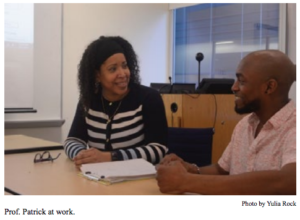Patrick Teaches Communication with a Critical Edge
 “I think I started because I love to dance, and I really started moving into the area of communication when I started dancing. I danced, I acted, I sang.” That’s how Professor Denise Patrick explains how she became a college faculty member in the area of communication studies.
“I think I started because I love to dance, and I really started moving into the area of communication when I started dancing. I danced, I acted, I sang.” That’s how Professor Denise Patrick explains how she became a college faculty member in the area of communication studies.
A native New Yorker, Patrick received a bachelor’s degree in corporate communication from Baruch College and a master’s in Rhetoric and Communication from Temple University in Philadelphia. She would later return home to become a lecturer in the Department of Communication Studies at the Weissman School of Arts and Sciences in Baruch College, CUNY.
When she was young, Patrick wanted to communicate with her body, but someone told her that was not possible, and she thought, “What’s interesting to me is how people kind of deal with each other, how they negotiate, how we listen to each other, how we sort of send messages, and I really just got more and more interested in that whole process.”
There is an old saying that goes, “All of the problems in the world are communication problems,” and Patrick thinks there is some truth in that. “When we think of an issue that we have in the world, when we think of the issues that we have one-on-one with people, it’s usually because we haven’t heard them properly, or we haven’t sent a message in the way we’ve intended or sent it properly so that the other person understands it. But there’s a little more to it than that. There’s also the context around a situation.”
One wonders to what extent mobile devices are changing the way we humans communicate. “Our electronic devices are tools, and I think that when they first came out, we used them more as tools to extend our conversations. Now, I find that people, particularly our students and their generation, they’re using them as their main form of communication. So you really miss the subtle nuances that we have when we’re face to face,” she says.
But do we know that electronic communication is not working in the world of emails and text messages? “My absolute rule is, when you get to the third email, stop, pick up the phone, or go see the person. Because it’s too much,” says Patrick.
The other problem is that people receive a lot of information, and they don’t look at it with critical eyes, and part of the blame falls on the way we educate today. “Regardless of the industry that our students go into, the people who will be employing them are looking for key things. Whether it’s students or not, they’re looking for new hires who have very strong communication skills. They’re also looking for people who are creative, they’re looking for people who can collaborate, they’re looking for leaders, and finally they’re looking for critical thinkers. If we in higher education don’t insist that our students think critically about every message they receive, we’re really doing them a disservice.
Patrick teaches students that employers today hire people because they have a particular skillset, but they also want people who can think outside the box, who can discern when something is false, discern when something is real, develop their own opinions about something and articulate them.
She also knows that not everybody is a natural communicator. “Some people do just have that natural gift. But all people can learn how to communicate better. It’s really understanding your style. The more that we can understand our own style—which means understand our strengths and understand our trouble spots—the better we can become at it,” she says.
As a preacher herself, Patrick knows that you have to understand your audience, which is very different from what you say or do in a business. She uses as an example one of the best communicators in history. “Martin Luther King Jr.’s practice in preaching really helped him develop and hone the skills of knowing how to say what he needed to say, how to pick a specific audience, how to get everyone on board with what his message was, and that’s a gift.”
She also reminds us that body language plays a big role in communication. “Our body language, our tone makes up 93 percent of our communication; the words are only 7 percent. Really what we’re getting meaning from is what we’re seeing and what we’re hearing.”
But that’s not all. Patrick says that actions also speak volumes about what you are trying to communicate and also about the importance of getting everybody on the same page. “Your actions speak. People tend to look at your actions. It may have been a mistake for that particular individual to be absent at the beginning, but the person may have had a very legitimate reason for being absent. And that’s why everybody has to be on the same page.”
She also knows that people have biases when it comes to listening to others. “I think when I was younger I would sit and say, ‘Oh my goodness, because it’s a woman people aren’t going to take her seriously . . .’ I think we all have that. I think we have tried to become a little bit savvier and not necessarily say, ‘Okay, I’m gonna have this implicit bias about this particular person.’ I myself really try to see what the person is. What is your character? That’s what’s important to me. I hope we can get closer and closer to that.”
PDF Version:
Patrick Teaches Communication with a Critical Edge